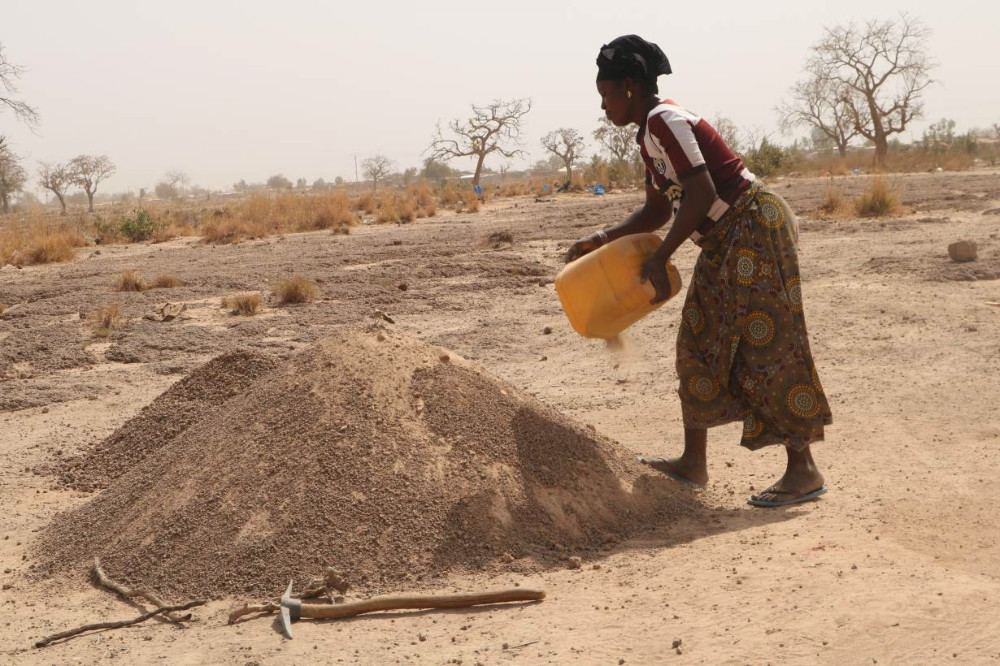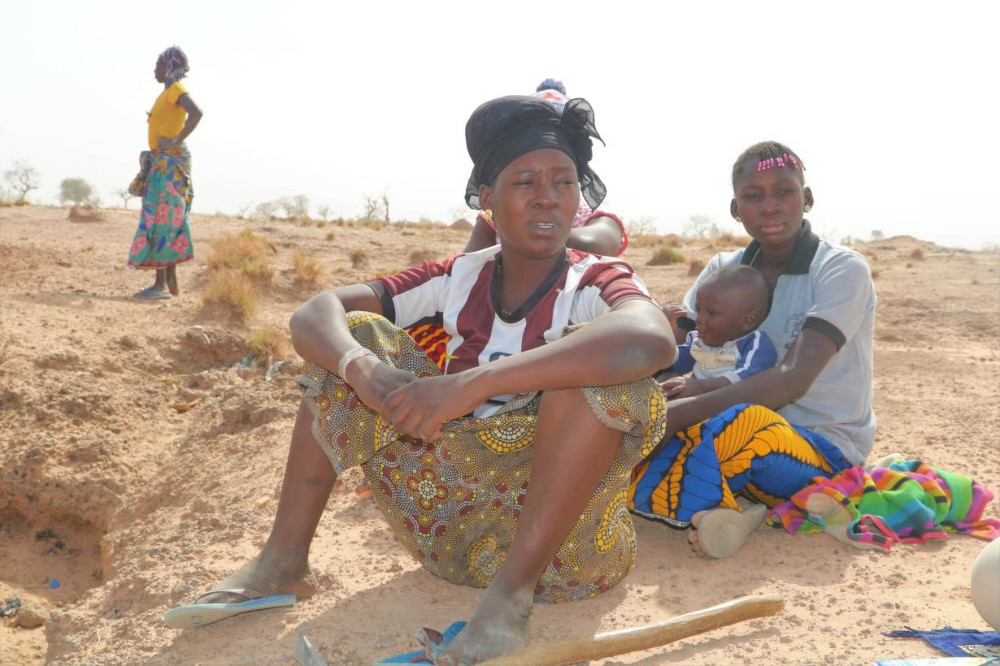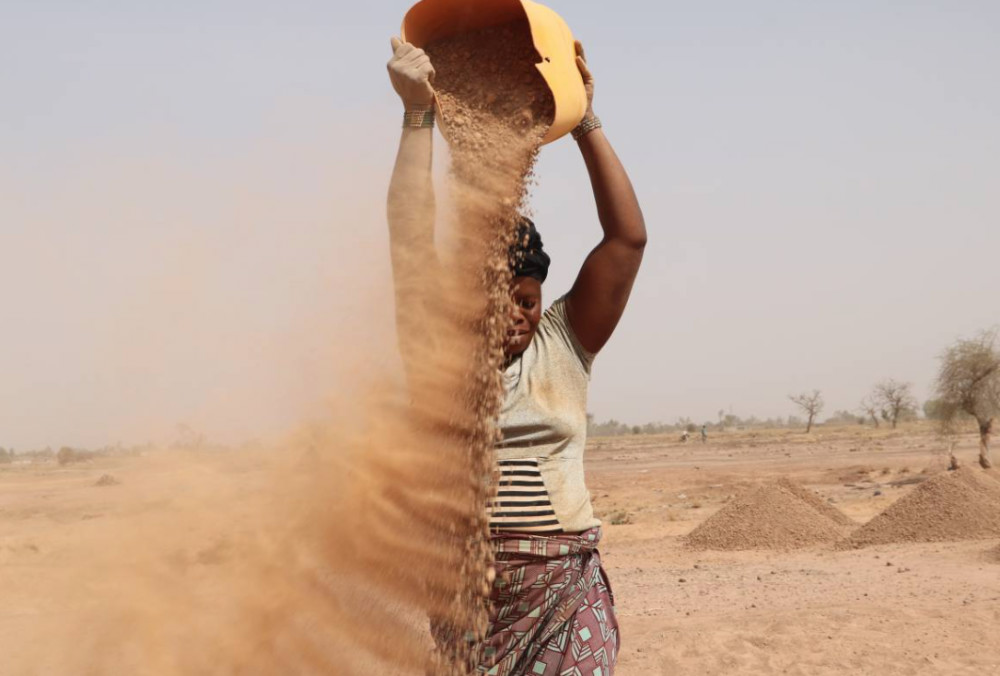
SAM MEDNICK, of Thomson Reuters Foundation, reports on the impact of drought and desertification on women in the landlocked West African nation…
Ouagadougou, Burkina Faso
Thomson Reuters Foundation
Wiping her sandy fingers on her shirt, Balkissa Sawadogo for a moment rests her aching body from shovelling sand and gravel into piles.
Three years ago, as rains dried up, the 25-year-old single mother was forced to stop farming in her neighbourhood on the outskirts of Burkina Faso’s capital Ouagadougou to begin the back-breaking work of selling sand to construction workers to support her family.
Her landlocked West African nation has been hard hit by drought and desertification caused in part by climate change.
Once-fertile land is now dry, forcing farmers that used to survive by cultivating it to change professions, often toiling from dawn until dusk in jobs that make it hard to scrape by.
“In the past, life was easier. There were a lot of trees, but now everything that was there has dried up,” said Sawadogo, pointing to the barren landscape around her.
“There are a lot of problems. We don’t eat enough, there’s not enough money, sometimes people get sick,” she said.

Balkissa Sawadogo throws sand – which she gathers and sells to builders because she can no longer farm – onto a mound on the outskirts of Burkina Faso’s capital, Ouagadougou, on 1st March. PICTURE: Thomson Reuters Foundation/Sam Mednick
While Burkina Faso emits just 0.01 per cent of planet-heating global emissions, the country is ranked the 20th most vulnerable to climate impacts, said Richard Munang, Africa climate coordinator for the United Nations Environmental Program.
Heat waves, floods, strong winds and dust storms have contributed to more than one-third of Burkina Faso’s land becoming degraded, according to the government and the United Nations, pushing people who once depended on farming into greater poverty.
“The poor are unable to afford the goods and services they need to buffer against the worst of the changing climate.”
– Richard Munang, Africa climate coordinator for the United Nations Environmental Program
“The poor are unable to afford the goods and services they need to buffer against the worst of the changing climate,” Munang said.
In the last six years, Sawadogo has been forced out of farming twice, unable to grow crops as a result of diminishing rains, she said.
Ten years ago, she cultivated rice, maize and groundnuts with her family on land about four kilometres from Ouagadougou. While they never had an abundance, it was enough to survive, she said.
But in 2015, a lack of rain led them to search for more promising land. Her family moved to the outskirts of Ouagadougou and started farming – but three years later, that too dried up, she said.
The situation worsened when desperate farmers, unable to cultivate and in need of money, started cutting down trees to sell, she said, a move environmentalists say can accelerate the process of land degradation and further reduce rainfall.
Families, unable to grow enough crops, instead have had to rely on their savings to buy food, Sawadogo said – but food prices also have been rising.
A one-kilogram bag of maize that cost less than a dollar in 2013 has more than doubled in price, she said – and it takes two days to shovel the small mound of sand she can sell for approximately $US3.60.
The money isn’t consistent either, she said, and is not enough to feed and send her three children to school. To do that she needs at least $US180 a month – but she earns at best $US36.

Balkissa Sawadogo sits on the ground on the outskirts of Burkina Faso’s capital, Ouagadougou, where she shovels gravel to sell to builders because she can no longer cultivate crops, on 1st March. PICTURE: Thomson Reuters Foundation/Sam Mednick
Environmentalists in Burkina Faso say the situation is worsening and more unpredictable weather patterns are making it ever harder for farmers to plan.
Last year, rains that usually start in June or July began instead in May, meaning many people were unprepared and started cultivating too late to take advantage of the moisture, said Mathieu Ouedraogo, president of MARP Network Burkina, an environmental research group.
The already bad situation is compounded by some coping mechanisms – like mining sand and gravel, he said. As the earth is dug up and sand removed, the land retains less water when it does rain, and erosion can be set in motion, he added.
Under a program called “Make the Sahel Green Again”, Ouedraogo’s organisation teaches communities to plant and mulch trees, to drive regeneration.
Burkina Faso’s government also is trying to help struggling farmers access maize or millet varieties bred to grow more quickly or better tolerate weather extremes, said Arouna Dolobzanga, head of climate change adaptation at the environment ministry.
Burkina Faso’s government also is trying to help struggling farmers access maize or millet varieties bred to grow more quickly or better tolerate weather extremes, said Arouna Dolobzanga, head of climate change adaptation at the environment ministry.
As well, it is encouraging farmers to change their techniques – such as planting crops in water-capturing depressions, or building stone barriers to stop water runoff, he said.
But adapting to climate change costs money and the warmer it gets the more costly it becomes.
Highly vulnerable regions like Africa need at least $US7 billion to $US15 billion a year to adapt – an amount expected to grow to between $US50 and $US100 billion a year by 2050, said Munang of UNEP.
Warming above two degrees Celsius could potentially lead to a 25 per cent decrease in the yield of certain crops in Burkina Faso, according to a 2018 report on climate change in West Africa by the United States Agency for International Development.
Global average temperatures have already risen about 1.2 degrees above pre-industrial times, scientists say.

Bintou Ouedraogo pours gravel – which she gathers and sells to builders because she can no longer farm – onto a mound on the outskirts of Burkina Faso’s capital, Ouagadougou, on 1st March. PICTURE: Thomson Reuters Foundation/Sam Mednick
Climate change pressures near Burkina Faso’s urban areas are compounded by a recent government push to create more affordable housing, which means large amount of farmland are being cleared for construction.
Sawadogo and other women she works with say they’ve been told by the government they’ll have to leave their area on the capital’s outskirts in two years to make way for housing development.
While they’ve been told they will be moved to another plot of land, Sawadogo worries it might not have sand and gravel to shovel, which would leave her with few options to earn a living.
“They said we have to leave this place, but I don’t want to move,” she said, hanging her head. “I don’t know if there will be the same opportunities there.”





